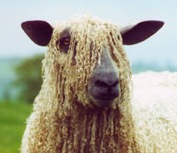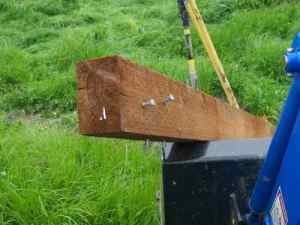 These days my mind is filled with sheep considerations. I am going to visit this Wensleydale sheep flock in a week, so I have been doing a lot of reading about them, and about sheep breeds in general. There is a huge variation in price between the breeds, and between registered purebreds and crossbreeds. And there are many pro’s and con’s to weigh.
These days my mind is filled with sheep considerations. I am going to visit this Wensleydale sheep flock in a week, so I have been doing a lot of reading about them, and about sheep breeds in general. There is a huge variation in price between the breeds, and between registered purebreds and crossbreeds. And there are many pro’s and con’s to weigh.
I can get a plain ol’ mixed breed wool sheep off of craigslist for easily $100, sometimes less. Wensleydales in general run from $800-$2000, by the looks of things; with maybe a poor-quality, low-percentage wether going for more like $350 (and that still seems too expensive to eat!!). Pro: This flock I’m considering is discounted if I buy the whole lot of them, because the owners are retiring, they are offering financial incentive to take them all at once. So, if Wensleydales are what I’m after, it’s a great opportunity price-wise as well as getting access to someone’s choice breeding stock. This is opposed to having to breed-up from second-choice animals that someone else culled out of their flock.
Pro: In theory, if they lambed a good crop next spring, the investment could not only pay for itself, but become profitable in the first year. Con: But, that’s making a lot of assumptions: that prices hold, that I can find buyers, that coyotes won’t get any, that I won’t have to buy a lot of supplemental feed, that I don’t have any horrendous vet bills, that the whole shearing thing works out, and that I won’t make some terrible management mistake and have a bunch of losses while I’m learning the ropes.
Pro: The owner reports that Wensleydale values have been staying strong, and indeed the few websites in the whole country where I can find prices, they are high! But, what I don’t know is how long you have to hold animals to find buyers, and where you find buyers. So, that is something I want to ask more about. Con: And, then, there is the fact that she’s not selling hers very fast—they’ve been for sale for at least two months, and it doesn’t look like she’s sold a single one! I’m not sure what to make of that!
Pro: On the other hand– $100 sheep beget $100 sheep, and all qualities of sheep eat about the same amount of feed. So, if I can sustain expensive sheep on the same grass and find adequate market for them, the income potential for that piece of ground goes way up! Con: And yet, I’ll probably never feel I can afford to eat any of these expensive things, and part of the reason of getting sheep is to have lamb!
Pro: I do prefer registered purebreds for sure. There are a lot of advantages to purebreds-they are predictable in size, temperament, appearance, health history and quality of carcass, wool, or whatever else you are breeding them for. Mixed breeds are a roll of the dice every time.
And, more pro’s: the sheep are beautiful, the wool is incredible, they are a “heritage breed,” which I favor over modern breeds. I enjoy having unique things, so it would be a novelty to be involved with such an unusual breed recreation project in the U.S. So, I am leaning towards “yes”; but still have some thinking and research to do!
 This was what I was going for with the grain feeding and ewe “flushing”- a perfect line with each ewe eating out of her own bucket. That way I can manage how much each one eats, and prevent the big ewes from hogging most of the grain. It only took about a week of effort for them to learn to come for grain, and seek out their own bowls. The bowls break my “no plastic” rule a little bit, but these were cheap paint buckets from Home Depot.
This was what I was going for with the grain feeding and ewe “flushing”- a perfect line with each ewe eating out of her own bucket. That way I can manage how much each one eats, and prevent the big ewes from hogging most of the grain. It only took about a week of effort for them to learn to come for grain, and seek out their own bowls. The bowls break my “no plastic” rule a little bit, but these were cheap paint buckets from Home Depot.
 Here are the hoof trimmers I like to use. Though even garden pruners will do, I like these straight and pointy cutters. They can really dig in and open up tiny crevices.
Here are the hoof trimmers I like to use. Though even garden pruners will do, I like these straight and pointy cutters. They can really dig in and open up tiny crevices. These days my mind is filled with sheep considerations. I am going to visit this Wensleydale sheep flock in a week, so I have been doing a lot of reading about them, and about sheep breeds in general. There is a huge variation in price between the breeds, and between registered purebreds and crossbreeds. And there are many pro’s and con’s to weigh.
These days my mind is filled with sheep considerations. I am going to visit this Wensleydale sheep flock in a week, so I have been doing a lot of reading about them, and about sheep breeds in general. There is a huge variation in price between the breeds, and between registered purebreds and crossbreeds. And there are many pro’s and con’s to weigh. 

